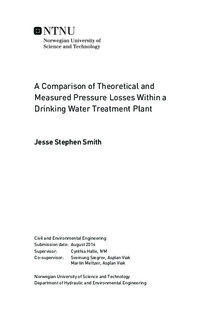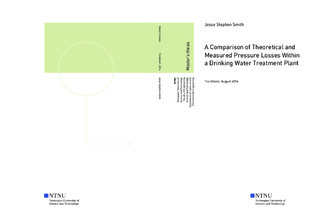| dc.description.abstract | Pressure loss and its effects on the resulting hydraulics within a drinking water treatment plant are extremely important aspects of design and operation. Pressure losses are important to monitor as they are the driving force within the system. If too much pressure is lost, a treatment plant may by unable to fulfill the networks water demand. In addition, the plants ability to effectively clean water may be compromised. Calculating the theoretical pressure loss is the key to designing a new treatment plant, however, the values calculated and those observed once set in operation, do not always compliment each other. Theoretical losses can be used to properly design a treatment plant, but the actual losses may vary, as some components may not function as desired.
In this project, a reusable Microsoft Excel spreadsheet was developed for calculating the pressure loss within a coagulation/filtration drinking water treatment plant located in Treungen. The calculated results were compared with those observed at the treatment plant through the help of a digital manometer.
The Microsoft Excel spreadsheet was capable of producing adequate pressure loss predictions for the entirety of the plant. For the raw water entering the plant and traveling to the filter, Excel produced results with an error of only 3.4%, while the clean water exiting the filter and entering the network produced a factor of error of approximately 16%. Major considerations to why the percent error for water within the clean water section was so much higher, is likely due to the multiple check valves following the four parallel filters. These check valves are used to ensure one directional flow within the treatment plant. The minor loss coefficient was determined to fluctuate over a wide range for the tested flow rates. The coefficient was calculated to be as low as 5.12 per valve, and as high as 19.9 per valve.
The percent error within the calculated theoretical results may be diminished through the use of further validation of the Excel spreadsheet. This can be done through use of the spreadsheet to compare the produced theoretical results, with those observed within other drinking water treatment plants. It could also be used for further evaluation of the Treungen treatment plant, in an attempt to minimize the percent error. By increasing the number of treatment plants where observed results can be compared to those produced by this spreadsheet, a final improved version could be produced, capable of reducing the workload of designing a new drinking water treatment plant. | |

